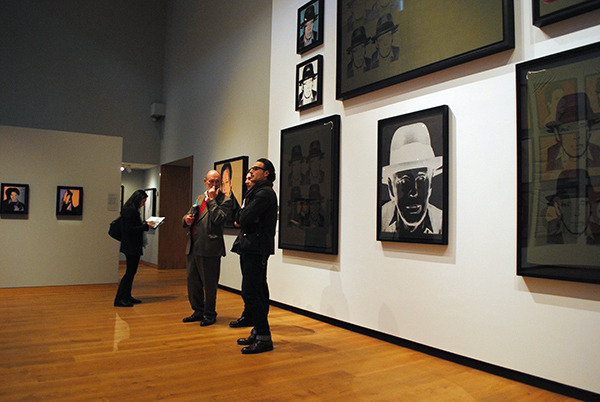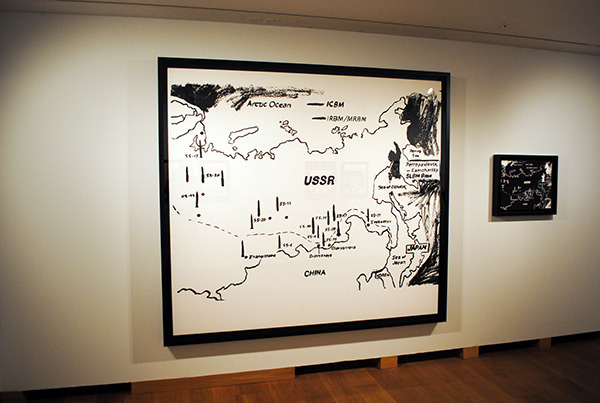Artlyst has recently attended the new exhibition of works by Andy Warhol from the Hall Collection, curated by Norman Rosenthal, on show at the Ashmolean Museum, Oxford. This is the latest exhibition in a number of Rosenthal-curated shows from the collection to take place at the museum in collaboration with the Hall Art Foundation, and includes over 100 paintings, sculptures, screen prints and drawings from the collection, exhibited alongside loans of the artist’s films from The Andy Warhol Museum in Pittsburgh.
 Image: The American Man (Portrait Of Watson Powell), 1964. Andy Warhol: Works from the Hall Art Foundation, Ashmolean Museum. Photo: P A Black © Artlyst 2016.
Image: The American Man (Portrait Of Watson Powell), 1964. Andy Warhol: Works from the Hall Art Foundation, Ashmolean Museum. Photo: P A Black © Artlyst 2016.
The show is not your usual retrospective of the artist’s work, but in fact a number of slightly lesser-viewed works taken from the collection. Andrew Hall collected the Warhol’s because he liked them, and not to build a portfolio of valuable works, hence the collection on display has a very personal feel, and sheds a different light on the work of the Pop Art genius – that even Robert Hughes may have liked – well, maybe not.
Hall, an Oxford graduate and collector of art, chose to collect the more unusual works by Warhol, and here, curated by Rosenthal, there is a dark side to this new-found intimacy with the late artist. The exhibition opens with Warhol’s early Pop portraits, and includes works from key series such as Flowers and Brillo Soap Pads Box; a group of artists’ portraits which features Roy Lichtenstein, James Rosenquist and Frank Stella; a light enough beginning to the exhibition it would seem, but now charged with the passing of time, the works become history paintings, faces from the past, which litter the exhibition – still standard Warhol one would think – but the tone of the work has been changed by the inclusion of smaller works from the collection.
 Image: Portraits of Joseph Beuys, Andy Warhol: Works from the Hall Art Foundation, Ashmolean Museum. Photo: P A Black © Artlyst 2016.
Image: Portraits of Joseph Beuys, Andy Warhol: Works from the Hall Art Foundation, Ashmolean Museum. Photo: P A Black © Artlyst 2016.
Scale is key here; there are a number of smaller works on display that Warhol also recreated on a much larger scale, these smaller works highlight the inception of the artist’s ideas, drawing you closer to the real Warhol, unlike his larger-scale works these pieces offer a more personal experience of the artist’s concerns with death and celebrity than say, Warhol’s electric chairs, or car crashes, wherein the artist in fact distances himself and the viewer from the emotion of the subject matter.
Here the more intimate later paintings have a greater intimacy than for example, his Self-portraits and Skulls, which always exude that intentional impersonality (and fright wig) as if the self-portrait is a disguise. Here you get a little glimpse of the real Warhol, and he is more fragile and darker than one would expect. The bright Pop colours hide an obsession with death that was personal, with an eye that suggests Warhol himself, and not the work of one of his factory cohorts. The latter paintings are a fascinating insight into an ageing Andrew Warhola.
The core of the exhibition is a display of Warhol’s commissioned portraits spanning the 1970s right up to the year before his death. Grouped together they remind the viewer of the artist’s wish for his society portraits of this era to all hang together in a huge display at New York’s Museum of Modern Art. The works feature performers, socialites and politicians including the singer and songwriter, Paul Anka; American celebrities, Maria Shriver and Pia Zadora; the Princess of Iran. The display mirrors the artist’s wish and highlights his power as a 20th century portraitist.
 Image: Map of Eastern U.S.S.R. Missile Bases c.1985–6, Andy Warhol: Works from the Hall Art Foundation, Ashmolean Museum. Photo: P A Black © Artlyst 2016.
Image: Map of Eastern U.S.S.R. Missile Bases c.1985–6, Andy Warhol: Works from the Hall Art Foundation, Ashmolean Museum. Photo: P A Black © Artlyst 2016.
But from the painted map of every nuclear missile site in the USSR in 1985, “666 – Mark of the Beast” in another late work, to the ghostly prints of Joseph Beuys, leering out of his portraits like Lon Chaney, it would seem that the catholic Pop Art master’s true obsession was with his own mortality.
In this exhibition Warhol is haunting, enigmatic, and highly personal. Beneath the intimate works lay a fear of death, that one would expect began with Valerie Solanas in 1968, and concluded when the artist checked into hospital in 1987 under the pseudonym “Bob Robert” for a gallbladder operation that would prove fatal.
“Oh, I’m not going to make it,” the artist had told friends, before he slipped on a theatre gown, and slipped off this mortal coil.
About the Hall Art Foundation:
The Hall Art Foundation was founded in 2007 and makes available postwar and contemporary art works from its own collection and that of Andrew and Christine Hall for the enjoyment and education of the public. Together, the Hall and Hall Art Foundation collections comprise some 5,000 works by several hundred artists including Richard Artschwager, Georg Baselitz, Joseph Beuys, Olafur Eliasson, Eric Fischl, Joerg Immendorff, Anselm Kiefer, Malcolm Morley, A. R. Penck, Julian Schnabel, Ed Ruscha, Andy Warhol and Franz West.
In 2013, the Hall Art Foundation entered into a partnership with the Ashmolean Museum of Art and Archaeology in Oxford, England to present a series of exhibitions of contemporary and postwar art curated by Sir Norman Rosenthal.
Lead image: Andy Warhol working on The American Man (Portrait Of Watson Powell), 1964. Andy Warhol: Works from the Hall Art Foundation, Ashmolean Museum. Photo: P A Black © Artlyst 2016.
Words: Paul Black. Photos: P A Black © Artlyst 2016.
Andy Warhol: Works from the Hall Art Foundation – Ashmolean Museum, Oxford – until 15 May 2016.
